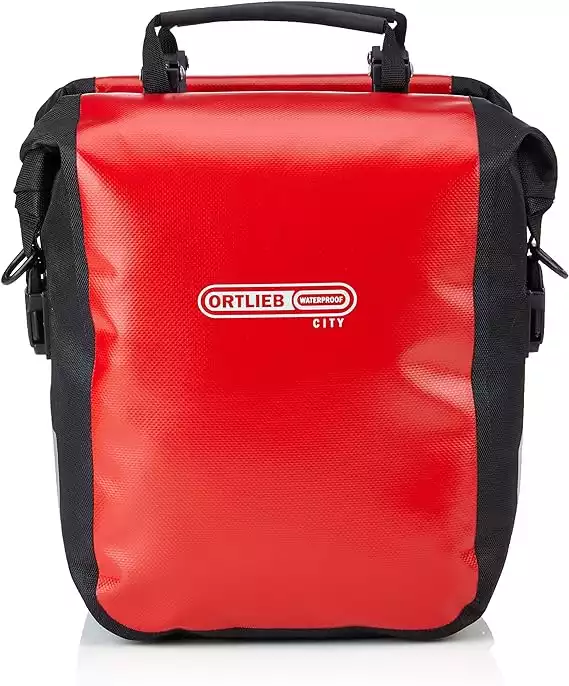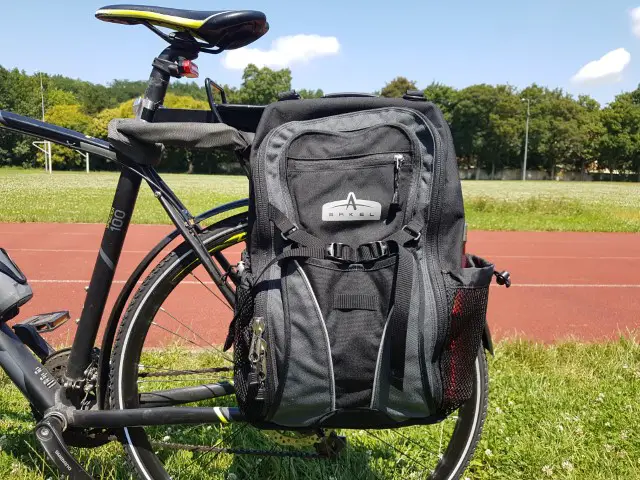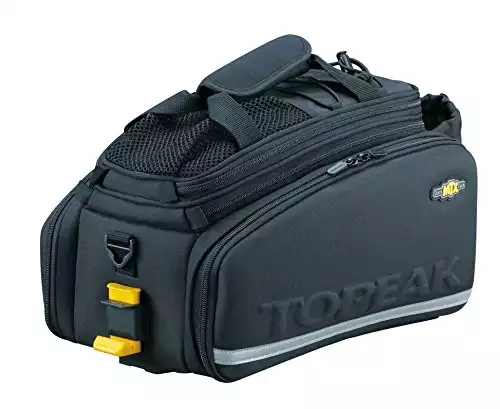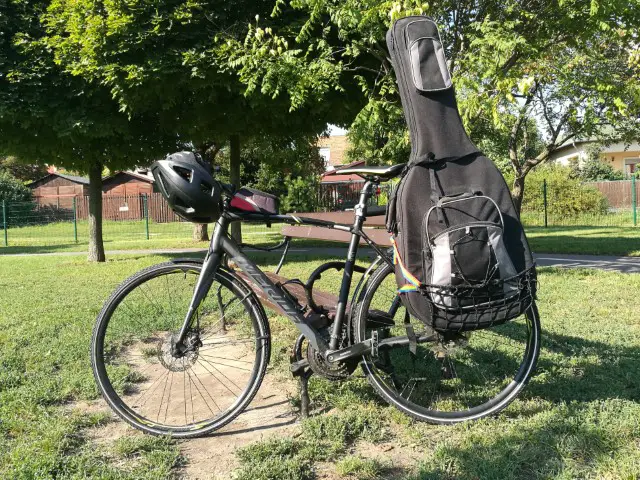For many people, cycling is not just a hobby or a way of getting some exercise, but it’s how they get around town and get things done. If you often find yourself making short trips alone, chances are you can replace your car with a bike for those trips. The main limitation of a bike is its carrying capacity. This is where a rear bike rack comes in handy.
The rear bike rack adds carrying capacity to your bike. It can carry one’s personal belongings or groceries by mounting bags and panniers, or by mounting a seat, it can carry children. A rear bike rack can carry 22-115 lbs (10 – 50 kg). Unlike front racks, it doesn’t affect the steering.
Let’s see first the most common uses for a rear rack and in the second part how to pick the best one for your needs.
What can you carry on a rear rack?
Panniers
Panniers are bicycle-specific bags that attach to a rear rack on either side of the wheel. They come in all shapes, sizes, colors, and fabrics. Some are made for touring, while others are great for commuting. They make riding super convenient since they free up your body from carrying a backpack.
Electric bikes built for everything and priced for everyone. Shop Rad Power Bikes, America's #1 electric bike brand. Get out. Go further. Ride Rad.
Touring panniers are typically large and waterproof, and they can hold a ton of stuff for days. The gold standard of panniers when it comes to touring is Ortlieb, which are not only durable, but they are completely waterproof too.
Ortlieb is pretty much the gold standard of waterproof, rugged panniers for touring and commuting.
Commuting panniers are smaller in volume, and they emphasize on practicality when it comes to carrying them at your destination. When you take off a commuter pannier bag from your rear rack, you can usually carry it as a messenger bag or a backpack. One that I personally use and love is the Arkel Bug, which turns from a backpack into a pannier in a matter of seconds.
I love this pannier backpack for the following reasons:
- Super durable design
- Good organization for stuff
- Looks good when worn as a backpack
- Bottle holders and reflective details all over
Basket
Baskets or milk crates are another simple but very effective way to carry stuff on your bike since you can place items in them directly. You can carry your chain, backpack, laptop bag, and clothes without fiddling with attaching anything to your bike.
While a basket may not look particularly cool on the bike, it’s hands down the fastest way of loading up your bike with extra cargo.
Tents, bags etc.
If you’re into multi-day bike trips, you may want to carry a tent or a backpack with you on the bike. These can be strapped directly on top of the rear rack with bungee chords or the spring loading mechanism built into the rack.

Some racks, like this Ibera Bike Rack on Amazon allow you to attach a pannier on either side, and it still has sufficient room to carry a tent or a bag on top.
Trunk bags
Trunk bags are small bags that can be mounted on top of the bike’s rear rack. They are small in volume, but they give convenient access to everything inside them via the flap open top. They are great for carrying cameras, snacks, tools, or a small jacket. They are helpful when you need to carry only some small items.
This trunk bag expands into panniers on the side giving you some extra capacity when you have some extra stuff for a day-trip or a light commute.
Child seat
If you want to carry a young passenger who doesn’t know how to ride a bike, you can fit a rack-mounted child seat on your bike. The typical weight limit of rack-mounted child seats is 40 lbs, which means that you can carry up to an average 4-year-old behind you.
Unlike most child seats, this one mounts directly on your bike rack so you don't need to attach an adapter to your bike frame.
Creative ways
There are many other creative ways to use your rear rack to carry a load. You can use bungees to attach backpacks, boxes, baskets, etc. One convenient way of adding extra carry capacity is with the Mundo AirPannier, which is essentially a net attached to two carabiners.

How to choose a rear rack?
Unfortunately, not all rear bike racks fit all bikes. Here are the most important questions to answer to decide which one to purchase.
Does your bike have eyelets?
Eyelets, also known as braze-ons, are the holes on your bike’s frame that allow you to attach a rack to. Look for these holes around the rear axle and the frame around the seatpost. Hybrids, trekking, fitness, gravel, and city bikes have braze-ons. Attaching a rear rack to them is done simply via hex bolts.
Some road bikes, cyclocross bikes, and mountain bikes don’t have braze-ons, so a rear rack can’t be mounted on them via bolts. In this case, you can use some accessories to add eyelets to your bike by using P-clamps or other mounting clamps, or you can use a setapost-mounted rear rack.
I wrote an article about these options here.
Permanent or temporary
Even if your bike has eyelets, you may not want to have a permanent rack on your bike. For example, I use my bike mainly for commuting, and I often use a pannier. However, I also like taking my bike on weekend rides where I don’t want to carry a lot of things with me, and I do not need a rack.
I chose a seatpost-mounted rack, which only holds up to 22 lbs (10 kg) but is sufficient for commuting. The best thing about it is that I can remove it or put it on in less than 30 seconds.
Wheel size and disc brakes
The next thing you need to make sure is that you get the right size rack for your bike. Adult bikes’ wheel sizes are either 26, 28 or 29 inches. A 26″ wheel is smaller than a 28″ one, and not all racks are compatible with all wheel sizes.
Thankfully many rear racks, such as this Ibera bike rack, are compatible with all wheel sizes so that you won’t bump into issues.
If your bike uses disc brakes, you need to make sure that the rack is disc brake compatible. Since disc brakes occupy some space on the side of the frame, the rack needs to have some spacers to fit.
Type of use
Depending on what you will carry on your rack, you need to look for certain features.
For example, touring racks are sturdy and have plenty of mounting possibilities. A practical touring rack can carry a lot of load, large cargo, and it sits far back enough to offer sufficient heel clearance. Touring racks often have weight limits of 55 lbs (25 kg) or more.
If your primary use is commuting, you can use a much simpler rack than a touring rack. A rack with less features often saves you some weight and bulk, and it will make your bike look less of a workhorse and a little bit sleeker. These racks usually hold less weight (40 lbs or around 18 kg).
Conclusion
A rear bike rack is a great addition to any bike, whether you’re a commuter, weekend rider or a bike tourer. It allows you to go further and carry more load on your bike.
Happy pedaling!







